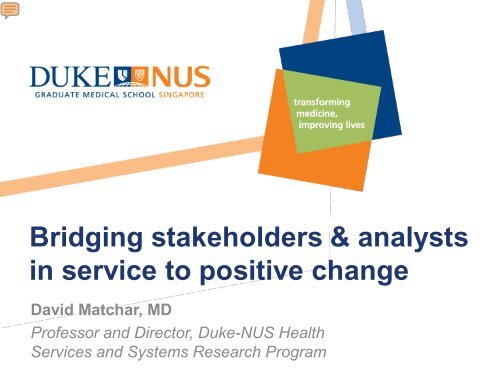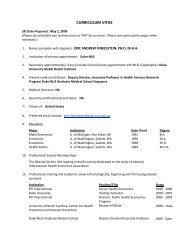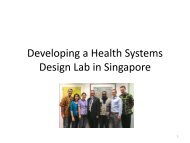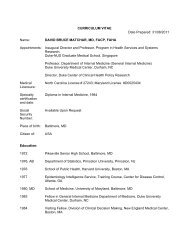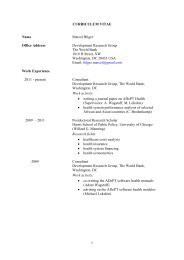Duke-NUS Corporate PPT - What is Health Services and Systems ...
Duke-NUS Corporate PPT - What is Health Services and Systems ...
Duke-NUS Corporate PPT - What is Health Services and Systems ...
- No tags were found...
You also want an ePaper? Increase the reach of your titles
YUMPU automatically turns print PDFs into web optimized ePapers that Google loves.
Bridging stakeholders & analystsin service to positive changeDavid Matchar, MDProfessor <strong>and</strong> Director, <strong>Duke</strong>-<strong>NUS</strong> <strong>Health</strong><strong>Services</strong> <strong>and</strong> <strong>Systems</strong> Research Program
Population aging in SingaporeProjected % increase inpopulation ≥65 years, 2000-2030Japan 54UK 55Germany 63United States 102Australia 108China 170Malaysia 277SINGAPORE 372<strong>What</strong> are our goals?A population that ages well;achieving th<strong>is</strong> in a way that <strong>is</strong>practical, acceptable, sustainable2
Dec<strong>is</strong>ions• <strong>What</strong> to change?– Long term social care– Medical care, especially forchronic conditions• <strong>What</strong> to change to?– Exp<strong>and</strong>ing ex<strong>is</strong>ting careservices– Developing new models ofcare• How to change?– Coordinated action3
“<strong>Health</strong> policy dec<strong>is</strong>ion makers have to make difficultchoices in a rapidly changing <strong>and</strong> highly complexenvironment, which often includes vast quantities ofcontradictory information. Th<strong>is</strong> task involvesbridging two d<strong>is</strong>tinct cultures—that of the analyst<strong>and</strong> that of the policy maker. Th<strong>is</strong> bridgingdem<strong>and</strong>s a strategy as well as a significantinvestment of time <strong>and</strong> a commitment. Modernhealth policy development requires more thantechnical excellence. It requires excellentrelationships between the analys<strong>is</strong> <strong>and</strong> policymakingcommunities.”Sarria-Santamera A, Matchar DB, Westermann-Clark E, Patwardhan MB. (2006). Evidencebasedpractice center network <strong>and</strong> health technology assessment in the United States:Bridging the cultural gap. International Journal of Technology Assessment in <strong>Health</strong> Care.5
CMS-sponsored technology assessment• Assess the benefits of FDG-PET scanning inpatients with dementia, with mild cognitiveimpairment (MCI) <strong>and</strong> in asymptomatic patientswith a family h<strong>is</strong>tory of AD, subsequent to thest<strong>and</strong>ard evaluation as described in theAmerican Academy of Neurology (AAN)guidelines7
Steps• Framing the problem• Examining the evidence• Synthesizing the evidence modeling• Communicating the results• Iterating…• Dec<strong>is</strong>ion making• Action8
Examining the evidence: PET <strong>and</strong>AD diagnos<strong>is</strong> in MCIMany fewer false positivesa few more false negativesTrue +False +False –True –CorrectClinicaldiagnos<strong>is</strong>(%) (%) (%) (%) (%)56 44 0 0 56PET 49 6 7 38 8711
Modeling to “fill the cheese”EpidemiologyStudiesOptionsAdmin<strong>is</strong>trativeDataOutcomesR<strong>and</strong>omizedTrialsBridgingModelPatientPreferenceDataExpertOpinion14
Illustrative patient h<strong>is</strong>toryYear1Asy MCI MiD MoD SeD D2Asy MCI MiD MoD SeD D3Asy MCI MiD MoD SeD D4Asy MCI MiD MoD SeD D17
ResultsNo PET/Treat allPET/Treat PositivesSurvival7.89 7.88Severe D<strong>is</strong>abilityfreeSurvival4.02 4.0018
Primary conclusion• PET could improve the overall accuracycompared to clinical exam• However, treatment based on an examleads to better health outcomes thantreatment based on PET results19
Communicating the results:How could th<strong>is</strong> be?• Recall: net accuracy with PET <strong>is</strong> better (many fewerfalse positives <strong>and</strong> a few more false negatives)• But, false positives ≠ false negatives– Incorrectly treating (false positive) <strong>is</strong> not as bad asincorrectly not treating (false negative)– Incorrectly treating:• Rx <strong>is</strong> relatively benign, may be beneficial even if patient does nothave AD– Incorrectly not treating:• Patient loses benefit of Rx20
Communicating the results:<strong>What</strong> do we need to know?• <strong>What</strong> <strong>is</strong> the loss from a false negative?– Does th<strong>is</strong> predict response to therapy?• <strong>What</strong> <strong>is</strong> the value of a true positive?– Do patients <strong>and</strong> families benefit from th<strong>is</strong> information?– Does earlier diagnos<strong>is</strong> by PET lead to more efficientevaluation?True -Value ofknowingTest True +TreatDelayedprogressionFalse -False +AdverseEventDecreasedmortality21
Thank Youdavid.matchar@duke-nus.edu.sgwww.duke-nus.edu.sg


